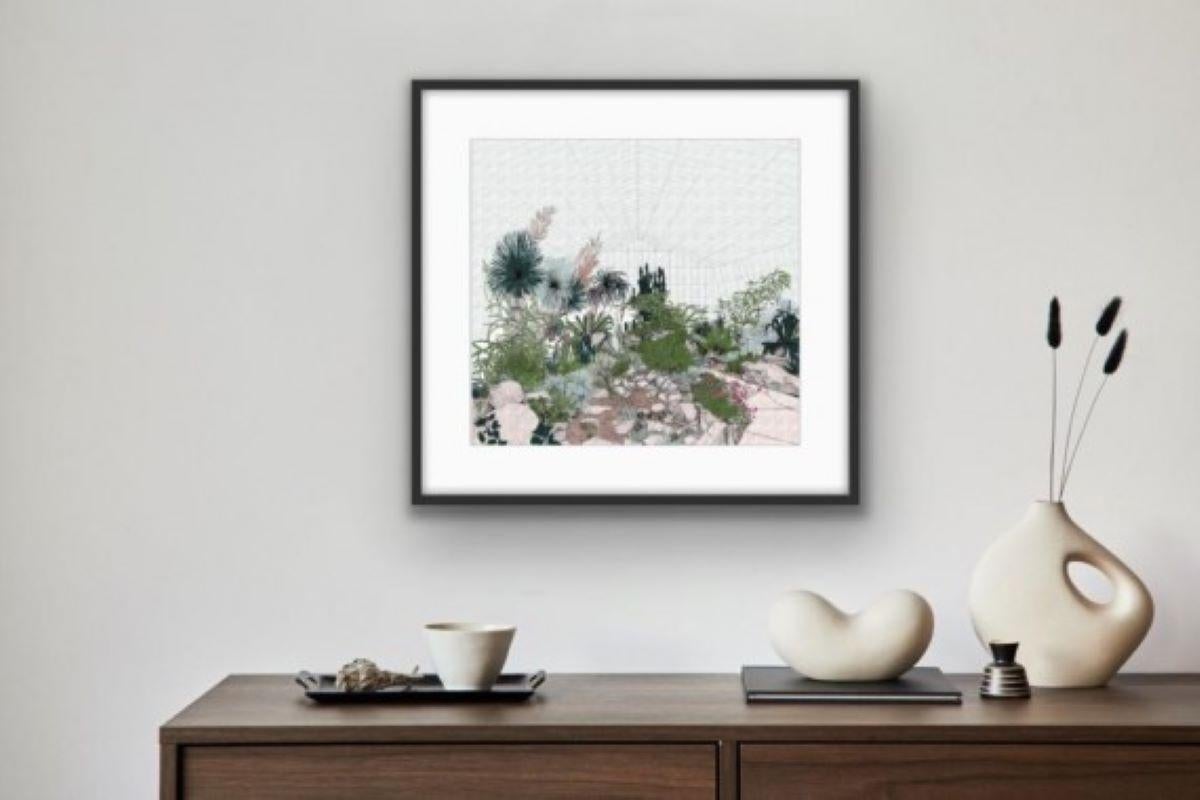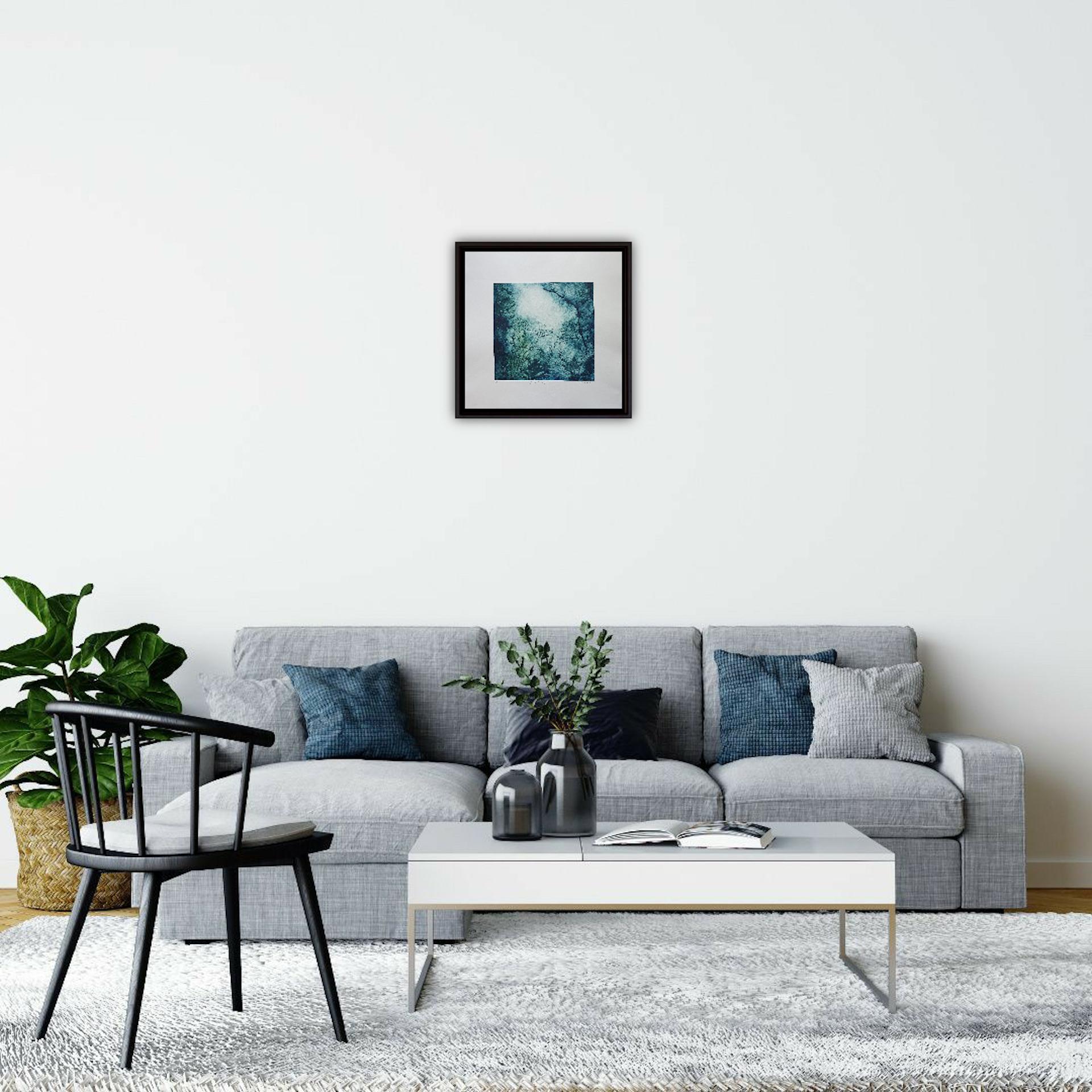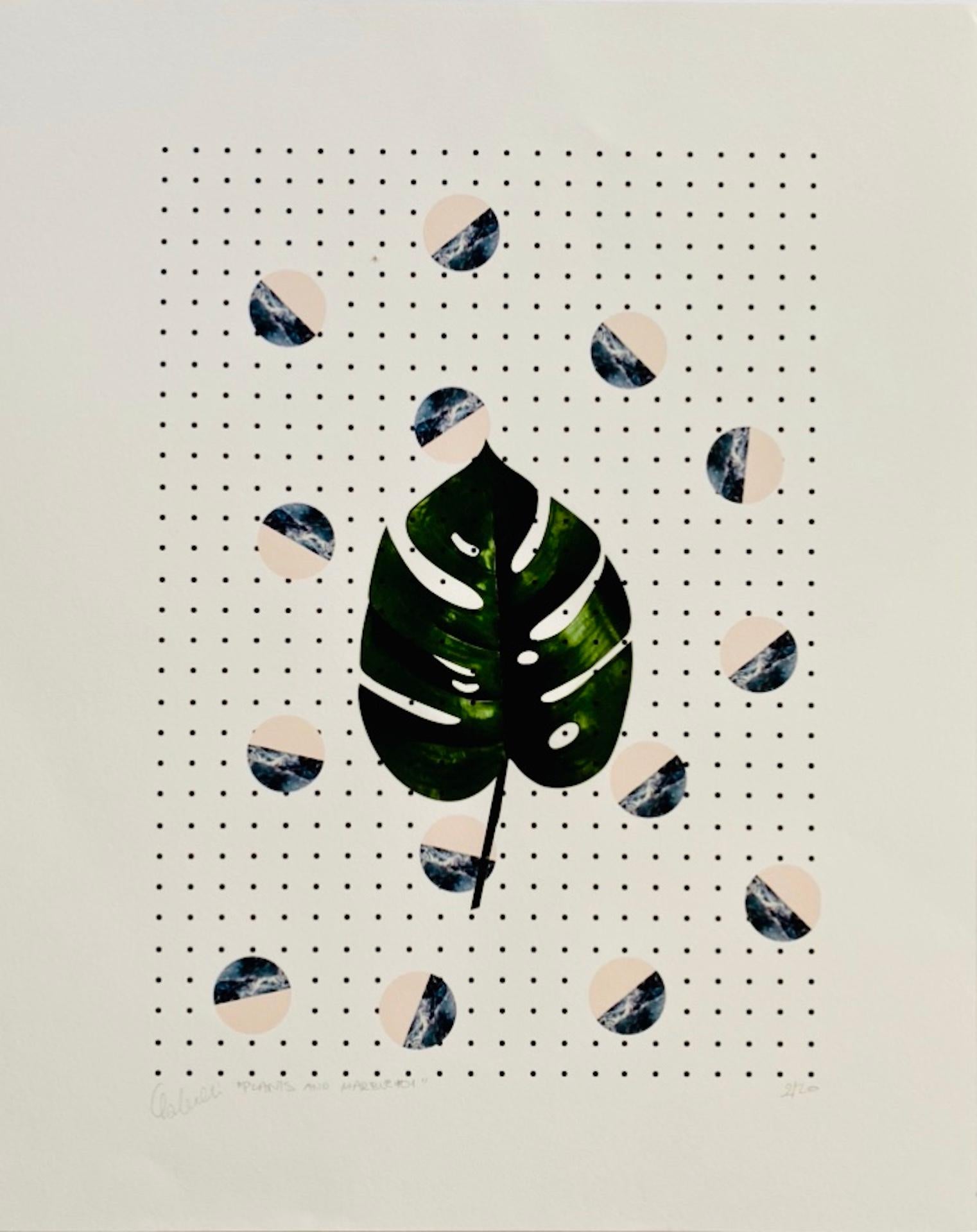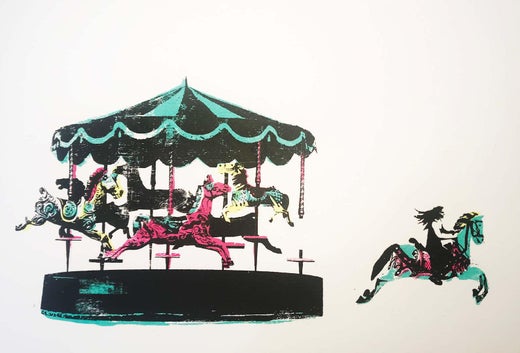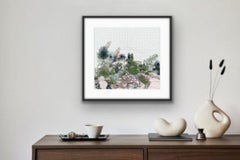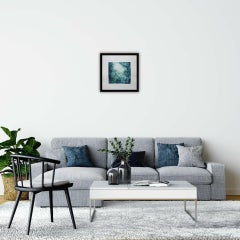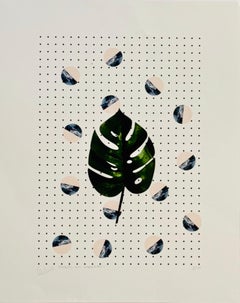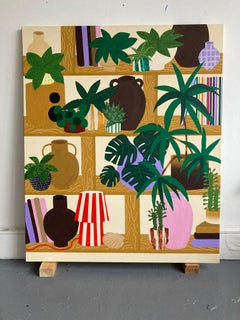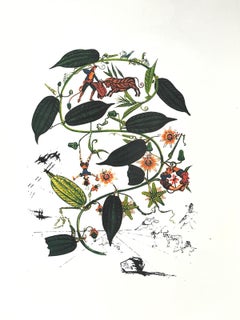Items Similar to Little Jungle, Katie Edwards, Limited Edition Print, Surrealist Landscape Art
Want more images or videos?
Request additional images or videos from the seller
1 of 12
Katie EdwardsLittle Jungle, Katie Edwards, Limited Edition Print, Surrealist Landscape Art
$138.76
£100
€118.25
CA$189.85
A$212.04
CHF 110.18
MX$2,582.24
NOK 1,399.57
SEK 1,318.80
DKK 882.32
Shipping
Retrieving quote...The 1stDibs Promise:
Authenticity Guarantee,
Money-Back Guarantee,
24-Hour Cancellation
About the Item
Katie Edwards
Little Jungle
Limited Edition 3 Colour Silkscreen Print
Edition of 100
Mounted Size: H 40.5cm x W 30.5cm x D 0.5cm
Sold Unframed
(Please note that in situ images are purely an indication of how a piece may look)
Little Jungle is a limited edition handmade silkscreen print by Katie Edwards. The bright colours and humorous titles make these cheerful works.
Katie Edwards produces conceptual illustrations for a wide range of clients from weekly editorials to large and prestigious ad campaigns. Screen prints for sale by Katie Edwards focusing on conceptual ideas, symbolism and metaphors. The innovative juxtaposition of elements often result in a surreal, humorous or thought-provoking image. Art has been a big part of Katie Edwards life and education, right through to graduating from Leeds Metropolitan University in Graphic Arts and Design with a First Class Honours. Working in London for five years as an artist and graphic illustrator, moving to Canada for two years and undertaking commissions’ for clients including Delta Airlines and Converse Shoes. Katie Edwards has since returned to back to where she grew up in the Lake District to continue her love of art.
- Creator:Katie Edwards (British)
- Dimensions:Height: 15.95 in (40.5 cm)Width: 12.01 in (30.5 cm)Depth: 0.2 in (5 mm)
- Medium:
- Movement & Style:
- Period:
- Condition:
- Gallery Location:Deddington, GB
- Reference Number:1stDibs: LU63236106122
Katie Edwards
Katie Edwards artist works are available with Wychwood Art online to buy and in our art gallery. Katie Edwards produces conceptual illustrations for a wide range of clients from weekly editorials to large and prestigious ad campaigns. Screen prints for sale by Katie Edwards focusing on conceptual ideas, symbolism and metaphors. The innovative juxtaposition of elements often result in a surreal, humorous or thought-provoking image. Art has been a big part of Katie Edwards life and education, right through to graduating from Leeds Metropolitan University in Graphic Arts and Design with a First Class Honours. Working in London for five years as an artist and graphic illustrator, moving to Canada for two years and undertaking commissions’ for clients including Delta Airlines and Converse Shoes. Katie Edwards has since returned to back to where she grew up in the Lake District to continue her love of art.
About the Seller
5.0
Platinum Seller
Premium sellers with a 4.7+ rating and 24-hour response times
Established in 2014
1stDibs seller since 2017
1,274 sales on 1stDibs
Typical response time: 1 hour
- ShippingRetrieving quote...Shipping from: Deddington, United Kingdom
- Return Policy
Authenticity Guarantee
In the unlikely event there’s an issue with an item’s authenticity, contact us within 1 year for a full refund. DetailsMoney-Back Guarantee
If your item is not as described, is damaged in transit, or does not arrive, contact us within 7 days for a full refund. Details24-Hour Cancellation
You have a 24-hour grace period in which to reconsider your purchase, with no questions asked.Vetted Professional Sellers
Our world-class sellers must adhere to strict standards for service and quality, maintaining the integrity of our listings.Price-Match Guarantee
If you find that a seller listed the same item for a lower price elsewhere, we’ll match it.Trusted Global Delivery
Our best-in-class carrier network provides specialized shipping options worldwide, including custom delivery.More From This Seller
View AllHot Mass of Cacti, limited edition print, plants, contemporary, cactus, nature
By Clare Halifax
Located in Deddington, GB
Hot Mass of Cacti [2020]
limited_edition
7-colour screen print on somerset silk
Edition number 100
Image size: H:50 cm x W:50 cm
Complete Size of Unframed Work: H:50 cm x W:50 cm...
Category
21st Century and Contemporary Contemporary Landscape Prints
Materials
Silk
Katie Edwards, Big Stick, Landscape Art, Animal Art, Dog Art, Affordable Art
By Katie Edwards
Located in Deddington, GB
Katie Edwards
Big Stick
Limited Edition Silkscreen Print
Edition of 50
Image Size: H 27.5cm x W 19.5cm
Mounted Size: H 40.5cm x W 30.5cm x D 0.5cm
Sold Unframed
Please note that in ...
Category
21st Century and Contemporary Abstract Expressionist Animal Prints
Materials
Paper, Screen
Charlie Davies, From the Depths, Contemporary Blue Print, Still Life Floral Art
By Charlie Davies
Located in Deddington, GB
Charlie Davies
From the depths
Original botanical etching
Soft ground etching on paper
Image Size: 35 cm x 35 cm x 1 cm
Sheet/Canvas Size: 50 cm x 50 cm x 1 cm
Unframed
Free Shipping...
Category
21st Century and Contemporary Abstract Abstract Prints
Materials
Paper, Etching
Fei Alexeli, Plants and Marble #1, Limited Edition Print, Affordable Art
By Fei Alexeli
Located in Deddington, GB
Fei Alexeli
Plants and Marble #1
Limited Edition Print
Giclee Print
Edition of 20
Image Size : H 38cm x W 27cm
Sheet Size: H 50cm x W 40cm
(Please note that in situ images are purely...
Category
21st Century and Contemporary Contemporary More Prints
Materials
Paper, Giclée
Jennifer Jokhoo, Hampstead NW3, Cityscape Art, Affordable Art, London Art
By Jennifer Jokhoo
Located in Deddington, GB
Jennifer Jokhoo
Hampstead NW3
Limited Edition Handmade Linocut Print
Edition of 20
Sheet Size: H 20cm x W 20cm x D 0.1cm
Sold Unframed
Please note that in situ images are purely an i...
Category
21st Century and Contemporary Contemporary Landscape Prints
Materials
Paper, Linocut
Wild Orchid, Limited edition print, Floral, Nature, Landscape
By Chris Keegan
Located in Deddington, GB
This is a lively Four colour hand made screen print featuring a wild Orchid growing in amongst tall woodland trees. The background metallic silver ink layer creates a negative white ...
Category
2010s Contemporary Landscape Prints
Materials
Screen
You May Also Like
Surreal Jungle - Landscape Painting by Marc Zimmerman
By Marc Zimmerman
Located in Carmel, CA
Surreal Jungle - Landscape Painting - Conceptual Art By Marc Zimmerman
This masterpiece is exhibited in the Zimmerman Gallery, Carmel CA.
Marc Zimmerman creates playful paintings,...
Category
2010s Contemporary Landscape Paintings
Materials
Canvas, Oil
TREE ROOTS II Signed Lithograph, Surreal Landscape, Jungle Forest Trees
By Hanna Kay
Located in Union City, NJ
TREE ROOTS II is an original hand drawn, limited edition lithograph printed using traditional hand lithography techniques on archival Arches paper 100% acid free. TREE ROOTS II is a ...
Category
1980s Surrealist Landscape Prints
Materials
Lithograph
$344 Sale Price
20% Off
It’s Like A Jungle Sometimes - Mid-Century Modern Art
Located in Manchester, GB
Hello Marine, It’s Like A Jungle Sometimes, 2024
Acrylic on canvas
Original artwork
120 x 100 cm ( 47.24 x 39.37 in )
Signed by the artist
Parisian artist HelloMarine has spent...
Category
2010s Contemporary Still-life Paintings
Materials
Oil Pastel, Acrylic, Canvas
Swirling Plants & Animals Limited Edition Lithograph after Dali
By (after) Salvador Dali
Located in Cirencester, Gloucestershire
After Salvador Dali (1904 - 1989)
limited edition lithograph, on thick paper, unframed
print: 16 x 12.5 inches
provenance: private collection, France
condition: very good and sound ...
Category
20th Century Abstract Still-life Prints
Materials
Color
"Jungle, " Color Lithograph Landscape signed by Carol Summers
By Carol Summers
Located in Milwaukee, WI
"Jungle" is an important, rare color lithograph signed by Carol Summers from the early years of his production. The image offers a landscape of a dark jungle, printed mostly in black ink. In the center, a blue pool of water is shaded by two trees. Summers' technique in this print renders a painterly quality to the image: the grasses and leaves of the scene are all created with playful, energetic swiping motions much like watercolor paint. This technique and the use of fields of color predict the style Summers would adopt in the coming decades, making this an important early work.
30 x 22 inches, artwork
Numbered 14 of the edition of 27
Carol Summers (1925-2016) has worked as an artist throughout the second half of the 20th century and into the first years of the next, outliving most of his mid-century modernist peers. Initially trained as a painter, Summers was drawn to color woodcuts around 1950 and it became his specialty thereafter. Over the years he has developed a process and style that is both innovative and readily recognizable. His art is known for it’s large scale, saturated fields of bold color, semi-abstract treatment of landscapes from around the world and a luminescent quality achieved through a printmaking process he invented.
In a career that has extended over half a century, Summers has hand-pulled approximately 245 woodcuts in editions that have typically run from 25 to 100 in number. His talent was both inherited and learned. Born in 1925 in Kingston, a small town in upstate New York, Summers was raised in nearby Woodstock with his older sister, Mary. His parents were both artists who had met in art school in St. Louis. During the Great Depression, when Carol was growing up, his father supported the family as a medical illustrator until he could return to painting. His mother was a watercolorist and also quite knowledgeable about the different kinds of papers used for various kinds of painting. Many years later, Summers would paint or print on thinly textured paper originally collected by his mother.
From 1948 to 1951, Carol Summers trained in the classical fine and studio arts at Bard College and at the Art Students League of New York. He studied painting with Steven Hirsh and printmaking with Louis Schanker. He admired the shapes and colors favored by early modernists Paul Klee (Sw: 1879-1940) and Matt Phillips (Am: b.1927- ). After graduating, Summers quit working as a part-time carpenter and cabinetmaker (which had supported his schooling and living expenses) to focus fulltime on art. That same year, an early abstract, Bridge No. 1 was selected for a Purchase Prize in a competition sponsored by the Brooklyn Museum.
In 1952, his work (Cathedral, Construction and Icarus) was shown the first time at the Museum of Modern Art in New York City in an exhibition of American woodcuts. In 1954, Summers received a grant from the Italian government to study for a year in Italy. Woodcuts completed soon after his arrival there were almost all editions of only 8 to 25 prints, small in size, architectural in content and black and white in color. The most well-known are Siennese Landscape and Little Landscape, which depicted the area near where he resided. Summers extended this trip three more years, a decision which would have significant impact on choices of subject matter and color in the coming decade.
After returning from Europe, Summers’ images continued to feature historical landmarks and events from Italy as well as from France, Spain and Greece. However, as evidenced in Aetna’s Dream, Worldwind and Arch of Triumph, a new look prevailed. These woodcuts were larger in size and in color. Some incorporated metal leaf in the creation of a collage and Summers even experimented with silkscreening. Editions were now between 20 and 50 prints in number. Most importantly, Summers employed his rubbing technique for the first time in the creation of Fantastic Garden in late 1957.
Dark Vision of Xerxes, a benchmark for Summers, was the first woodcut where Summers experimented using mineral spirits as part of his printmaking process. A Fulbright Grant as well as Fellowships from the Louis Comfort Tiffany Foundation and the Guggenheim Foundation followed soon thereafter, as did faculty positions at colleges and universities primarily in New York and Pennsylvania. During this period he married a dancer named Elaine Smithers with whom he had one son, Kyle. Around this same time, along with fellow artist Leonard Baskin, Summers pioneered what is now referred to as the “monumental” woodcut. This term was coined in the early 1960s to denote woodcuts that were dramatically bigger than those previously created in earlier years, ones that were limited in size mostly by the size of small hand-presses. While Baskin chose figurative subject matter, serious in nature and rendered with thick, striated lines, Summers rendered much less somber images preferring to emphasize shape and color; his subject matter approached abstraction but was always firmly rooted in the landscape.
In addition to working in this new, larger scale, Summers simultaneously refined a printmaking process which would eventually be called the “Carol Summers Method” or the “ Carol Summers Technique”. Summers produces his woodcuts by hand, usually from one or more blocks of quarter-inch pine, using oil-based printing inks and porous mulberry papers. His woodcuts reveal a sensitivity to wood especially its absorptive qualities and the subtleties of the grain. In several of his woodcuts throughout his career he has used the undulating, grainy patterns of a large wood plank to portray a flowing river or tumbling waterfall. The best examples of this are Dream, done in 1965 and the later Flash Flood Escalante, in 2003. In the majority of his woodcuts, Summers makes the blocks slightly larger than the paper so the image and color will bleed off the edge.
Before printing, he centers a dry sheet of paper over the top of the cut wood block or blocks, securing it with giant clips. Then he rolls the ink directly on the front of the sheet of paper and pressing down onto the dry wood block or reassembled group of blocks. Summers is technically very proficient; the inks are thoroughly saturated onto the surface of the paper but they do not run into each other. The precision of the color inking in Constantine’s Dream in 1969 and Rainbow Glacier in 1970 has been referred to in various studio handbooks. Summers refers to his own printing technique as “rubbing”. In traditional woodcut printing, including the Japanese method, the ink is applied directly onto the block. However, by following his own method, Summers has avoided the mirror-reversed image of a conventional print and it has given him the control over the precise amount of ink that he wants on the paper. After the ink is applied to the front of the paper, Summers sprays it with mineral spirits, which act as a thinning agent. The absorptive fibers of the paper draw the thinned ink away from the surface softening the shapes and diffusing and muting the colors. This produces a unique glow that is a hallmark of the Summers printmaking technique. Unlike the works of other color field artists or modernists of the time, this new technique made Summers’ extreme simplification and flat color areas anything but hard-edged or coldly impersonal.
By the 1960s, Summers had developed a personal way of coloring and printing and was not afraid of hard work, doing the cutting, inking and pulling himself. In 1964, at the age of 38, Summers’ work was exhibited for a second time at the Museum of Modern Art. This time his work was featured in a one-man show and then as one of MOMA’s two-year traveling exhibitions which toured throughout the United States. In subsequent years, Summers’ works would be exhibited and acquired for the permanent collections of multiple museums throughout the United States, Europe and Asia. Summers’ familiarity with landscapes throughout the world is firsthand. As a navigator-bombardier in the Marines in World War II, he toured the South Pacific and Asia.
Following college, travel in Europe and subsequent teaching positions, in 1972, after 47 years on the East Coast, Carol Summers moved permanently to Bonny Doon in the Santa Cruz Mountains in Northern California. There met his second wife, Joan Ward Toth, a textile artist who died in 1998; and it was here his second son, Ethan was born. During the years that followed this relocation, Summers’ choice of subject matter became more diverse although it retained the positive, mostly life-affirming quality that had existed from the beginning. Images now included moons, comets, both sunny and starry skies, hearts and flowers, all of which, in one way or another, remained tied to the landscape.
In the 1980s, from his home and studio in the Santa Cruz mountains, Summers continued to work as an artist supplementing his income by conducting classes and workshops at universities in California and Oregon as well as throughout the Mid and Southwest. He also traveled extensively during this period hiking and camping, often for weeks at a time, throughout the western United States and Canada. Throughout the decade it was not unusual for Summers to backpack alone or with a fellow artist into mountains or back country for six weeks or more at a time. Not surprisingly, the artwork created during this period rarely departed from images of the land, sea and sky. Summers rendered these landscapes in a more representational style than before, however he always kept them somewhat abstract by mixing geometric shapes with organic shapes, irregular in outline. Some of his most critically acknowledged work was created during this period including First Rain, 1985 and The Rolling Sea, 1989. Summers received an honorary doctorate from his alma mater, Bard College in 1979 and was selected by the United States Information Agency to spend a year conducting painting and printmaking workshops at universities throughout India. Since that original sabbatical, he has returned every year, spending four to eight weeks traveling throughout that country.
In the 1990s, interspersed with these journeys to India have been additional treks to the back roads and high country areas of Mexico, Central America, Nepal, China and Japan. Travel to these exotic and faraway places had a profound influence on Summers’ art. Subject matter became more worldly and nonwestern as with From Humla to Dolpo, 1991 or A Former Life of Budha, 1996, for example. Architectural images, such as The Pillars of Hercules, 1990 or The Raja’s Aviary, 1992 became more common. Still life images made a reappearance with Jungle Bouquet in 1997. This was also a period when Summers began using odd-sized paper to further the impact of an image.
The 1996 Night, a view of the earth and horizon as it might be seen by an astronaut, is over six feet long and only slightly more than a foot-and-a-half high. From 1999, Revuelta A Vida (Spanish for “Return to Life”) is pie-shaped and covers nearly 18 cubic feet. It was also at this juncture that Summers began to experiment with a somewhat different palette although he retained his love of saturated colors. The 2003 Far Side of Time is a superb example of the new direction taken by this colorist.
At the turn of the millennium in 1999, “Carol Summers Woodcuts...
Category
1960s Contemporary Landscape Prints
Materials
Lithograph
British Contemporary Print by Jane Ward - Overland No.3
By Jane Ward
Located in Paris, IDF
Digital print on canvas, edition 1/5, 90 x 120 x 3 cm, 2019
Jane Ward is a British artist born in 1960 who lives & works in Lake District National Park around Keswick and Grasmere, ...
Category
2010s Contemporary Landscape Prints
Materials
Canvas, Digital
More Ways To Browse
Shoes Limited Edition
Black Greek Statue
Bonded Bronze
Format Tie
Hare Sculpture Bronze
Pumpkin Box
Totem Native American
Weeping Willow Art
African Woman Bust
Alex Katz Blue
Archangel Painting
Cooking Book
Pierre Bonnard Sketch
Portrait Of Nobleman
Robert John Chair
Steamship Paintings
Tangier Paintings
Torah Paintings
